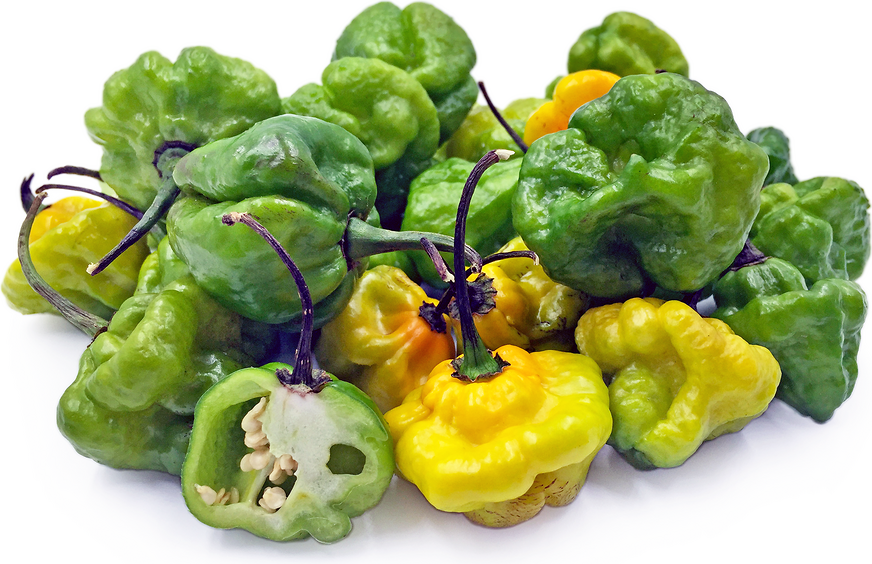


Scotch Bonnets Chile Peppers
Estimated Inventory, 7 lbs : 0
Description/Taste
Scotch Bonnet chile peppers are squat, gnarled pods, averaging 2 to 7 centimeters in length and 2 to 5 centimeters in diameter and have a flattened, irregular shape with four prominent ridges. The skin is waxy, wrinkled, and firm, maturing from green to yellow, orange, red, or brown when mature, depending on the variety. Underneath the surface, the flesh is crisp and pale green to yellow, red, orange, or brown, encasing a central cavity filled with small, round, and flat, cream-colored seeds. Scotch Bonnet chile peppers have a sweet fragrance and a fruity, floral taste mixed with notes of cherries, tomatoes, and apples followed by an intense, pungent heat.
Seasons/Availability
Scotch Bonnet chile peppers are available year-round with a peak season in the summer through fall.
Current Facts
Scotch Bonnet chile peppers, botanically classified as Capsicum chinense, are a very hot variety that belongs to the Solanaceae or nightshade family. Known by many different names across the Caribbean, its native land, Scotch Bonnet chile peppers are found under Jamaican pepper, Martinique pepper, Boabs Bonnet, Bahama Mama, Jamaican Hots, and Scotty Bons. Scotch Bonnet peppers can be found in varying sizes and shapes, depending on its growing environment and can be used at multiple stages of maturity, including its young green state and colorful, mature state. There are many different varieties of Scotch Bonnet chile peppers ranging in color from red, orange, to brown when mature. Scotch Bonnet chile peppers get their name from their similarity in shape to a traditional Scottish bonnet known as a Tam o’ Shanter. The peppers are considered very hot, averaging 100,000-350,000 SHU on the Scoville scale, and are utilized in a wide variety of raw and cooked applications. In Jamaica, Scotch Bonnet chile peppers are one of the country’s main exports and are traditionally used in Jamaican jerk seasoning and hot sauces. The peppers are so common on the islands that if a hot pepper is requested in local Caribbean markets, a Scotch Bonnet will primarily be given.
Nutritional Value
Scotch Bonnet chile peppers are an excellent source of magnesium and vitamins A and C, which are antioxidants that can help improve vision, boost collagen production, and protect the immune system. The peppers also contain flavonoids, phytochemicals, and a high amount of capsaicin, which is the chemical compound that triggers the brain to feel the sensation of heat or spice. Capsaicin has been shown to provide anti-inflammatory benefits.
Applications
Scotch Bonnet chile peppers are best suited for both raw and cooked applications such as boiling, sautéing, and frying. The peppers can be used whole and removed at the end of the cooking process to add minimal heat, or they can be sliced, minced, or chopped for the highest amount of spice and flavor. It is recommended that gloves and goggles are worn when handling the peppers as the high capsaicin content can irritate the skin and eyes. Scotch Bonnet chile peppers can be tossed into stews, soups, and curries, cooked into rice, or minced into Jamaican beef patties, which is a mixture of ground beef and spices wrapped in a dough and baked. They are also popularly blended into hot sauces, which are served as a condiment at every meal. In the Caribbean, Scotch Bonnet chile peppers are commonly added to fricasseed chicken, oxtail soup, and peppered shrimp. The peppers are also minced into vinegar-based sauces that are primarily poured over escoveitch, or fried fish. Scotch Bonnet chile peppers pair well with tropical fruits such as papaya, pineapple, and mango, tomatoes, onions, cilantro, lime juice, seafood such as shrimp, scallops, and white fish, and meats such as pork, beef, goat, and poultry. The fresh peppers will keep 1-2 weeks when stored whole and unwashed in the crisper drawer of the refrigerator.
Ethnic/Cultural Info
Scotch Bonnet chile peppers are a staple pepper in Caribbean cuisine, specifically Jamaican, Haitian, Trinidadian, and Grenadian. One of the most common uses for the peppers in the Caribbean is in spicy Jamaican jerk seasoning. Created through traditional African cooking styles mixed with indigenous ingredients, Jamaican jerk refers to a seasoning and cooking technique that was created by smoking meats over an open fire. Smoking the meat helped preserve the cut for an extended period, and the smoke also helped to keep insects away from the other raw meat that was being stored. Jamaican jerk seasoning uses a mix of Scotch Bonnet chile peppers, black pepper, scallions, onions, salt, thyme, and allspice and has become one of the most popular seasonings in Jamaica, used to flavor meats, fish, and vegetables. Small buildings known as jerk “huts” are commonly found alongside busy streets in Jamaica and consist of a central pole to support the roof with a fire smoking the meat outside. In addition to jerk seasoning, Scotch Bonnet chile peppers are also used in pepper sauce, which is a traditional condiment that is easily customized and used as a common flavoring.
Geography/History
Scotch Bonnet chile peppers are descendants of original pepper varieties native to the Amazon Basin and have been cultivated since ancient times. The peppers were then introduced into the West Indies via exploration of indigenous populations, and eventually, the islands began cultivating the peppers to create new cultivars that would, in time, become specifically adapted to each region. Today Scotch Bonnet chile peppers are grown mainly in the Caribbean on the island of Jamaica as the pepper thrives in the tropical climate in all fourteen parishes of the country. The peppers are used locally and are also exported into the United States, Central America, South America, and West Africa. Outside of the Caribbean, Scotch Bonnet chile peppers are available through online seed catalogs for home garden use and for regional, small scale cultivation.
Recipe Ideas
Recipes that include Scotch Bonnets Chile Peppers. One




